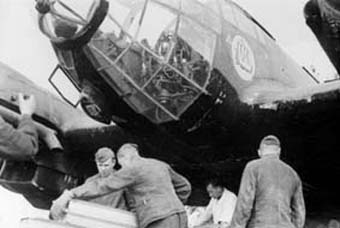
The
first Luftwaffe raids
against Moscow

The
first Luftwaffe raids
against Moscow

As a reaction of the stiffening Russian defense on the road to Moscow in July
1941, the Germans decided to divert a large part of their bomber fleet to terror
attacks against the Soviet capital. Already on July 8, Hitler had ordered Hermann
Göring to level Moscow and Leningrad with the ground – 'to make sure that there
will be left no inhabitants that we will have to supply during the winter.'
The final order for implementation of these raids came with the Führer's Order
No. 33 of July 19, 1941.
But the planned devastation of Moscow became a large failure, quite comparable to the air offensive against Great Britain during the previous year. The Soviet defense forces simply were too strong. As the air offensive against Moscow was commenced, General-Mayor Mikhail Gromadin's Moscow Air Defense District (Moskovskaya Zona PVO) had 585 fighters at its disposal - of which more than half were of modern models (170 MiG-3s, 95 Yak-1s, 75 LaGG-3s, 200 I-16s and 45 I-153s). The fighter planes were divided into twenty-nine Fighter Regiments in 6 IAK/PVO, led by Polkovnik Ivan Klimov.
Furthermore, the overall-commander of the Moscow air defence, General-Mayor Gromadin, had concentrated 1,044 AA guns and 336 machine guns in and around the capital. But the fighting spirit of Moscow's defenders was of as much importance as the numeral strength. 'I swear to you my country and to you my native Moscow that I will fight relentlessly and destroy the Fascists', read the oath sworn by the determinate fighter pilots of the capital's PVO. Such manifestations should not be underestimated in a country with people as drained with propaganda for 'revolutionary unselfishness' as the young Soviet republic. In fact, first major Soviet victory in the war was achieved in the air over Moscow.
The first air raid against the Soviet capital was launched during the evening on Monday July 21. 195 bombers – Ju 88s from KG 3 and KG 54, He 111s from KG 53, KG 55, KG 28, III./KG 26 and K.Gr. 100, and Do 17s from KG 2 and KG 3 – were concentrated against the Soviet capital. They were immediately encountered a strong defense. 170 Soviet fighters were sent to intercept the raiders. Particularly successful were the fighters of 11, 16, 27 and 34 IAPs. Heavy air fighting took place in the searchlight concentration zone in the Solnechnogorsk – Golitsyno area north-west of Moscow. The first aerial victory was scored by Starshiy Leytenant I. D. Chulkov of the MiG-3 equipped 41 IAP. Chulkov claimed an He 111 at 0210 hours. The Do 17 piloted by Leutnant Kurt Kuhn of 9./KG 3 was brought down by the famous Soviet test pilot Kapitan Mark Gallay. When captured, Kuhn attempted to hide the fact that he had bombed Moscow claiming that his bomber had carried no bombs.
Nearer Moscow, the German bombers were met by heavy AAA fire. In total, the anti-aircraft guns of 1 Korpus PVO reported the expenditure of 29,000 artillery shells and 130,000 machine-gun bullets during this raid. Yet, at the cost of four shot down aircraft, 104 tons of high explosives and 46,000 incendiaries were dropped by the attackers during this first raid. These raids caused heavy losses among the civilian population. But the real aim – to burn the Kremlin to ashes – failed completely. The bombs simply could not penetrate the thick, Seventeenth-century roofs on the main buildings in the Kremlin.
The attack was repeated with 115 bombers the following night. Kapitan Titenkov of 11 IAP and Mladshiy Leytenant Lukyanov of 34 IAP managed to bring down their second respective bombers in the illuminated night fighter zone 5. Soviet fighters and AAA claimed the destruction of 15 enemy bombers (the Germans admitted the loss of five). During the third Moscow raid on the night of the 24th, the attack force had been reduced to 100. Due to both the strong Russian defense and the impossibility to keep such a large portion of the diminishing German bomber force away from the growing difficulties at the front, the number of aircraft participating in each raid decreased from 100 during the third night to 50, 30, and finally no more than 15. Within short, the proud Luftwaffe 'offensive' against Moscow had been reduced to mere nuisance raids.
The most successful individual Soviet fighter pilot during the brief 'air battle of Moscow' was Kapitan Konstantin Titenkov, who scored one bomber on each of the four first raids, thus becomin decorated with the Order of Lenin and the Golden Star as a token of a Hero of the Soviet Union.
Sources:
Tagebuch GenO. Franz Halder.
Russian Military Archive TsAMO, Podolsk.
Bekker, Angriffshöhe 4000.